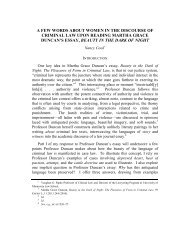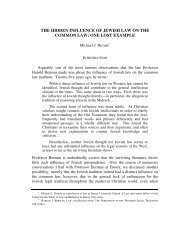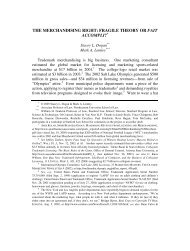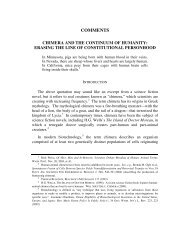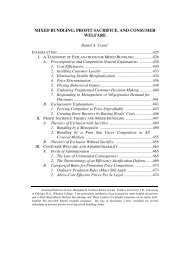life, liberty, and the pursuit of swords and armor - Emory University ...
life, liberty, and the pursuit of swords and armor - Emory University ...
life, liberty, and the pursuit of swords and armor - Emory University ...
Create successful ePaper yourself
Turn your PDF publications into a flip-book with our unique Google optimized e-Paper software.
1320 EMORY LAW JOURNAL [Vol. 57<br />
player begins to use <strong>the</strong> virtual good in a manner beyond his authority. 139 This<br />
requirement <strong>of</strong> control could prove problematic, given <strong>the</strong> intangibility <strong>of</strong><br />
virtual goods. The defendant does not actually exert control over <strong>the</strong> sword;<br />
his avatar merely creates <strong>the</strong> illusion <strong>of</strong> control. In reality, <strong>the</strong> only action that<br />
takes place is <strong>the</strong> transfer from one player account to ano<strong>the</strong>r <strong>of</strong> computer code<br />
that represents that sword. Moreover, <strong>the</strong> argument could be made that a<br />
person never actually controlled <strong>the</strong> virtual goods, but instead that <strong>the</strong> avatar<br />
alone performed <strong>the</strong> act. 140<br />
Courts are divided on <strong>the</strong> issue <strong>of</strong> whe<strong>the</strong>r “intangibles” may be “taken.”<br />
While one court has held that “where no tangible objects were ever taken or<br />
transported, a court would be hard pressed to conclude that ‘goods’ had been<br />
stolen,” 141 many courts are willing to accept that a thing has been taken if <strong>the</strong><br />
rightful owner is denied possession, regardless <strong>of</strong> tangibility, thus creating <strong>the</strong><br />
presumption that <strong>the</strong> o<strong>the</strong>r party has asserted control over <strong>the</strong> good. 142 A video<br />
game player may not physically hold <strong>the</strong> virtual sword, but his avatar’s actions<br />
produce <strong>the</strong> consequences that would be produced by an actual taking: (a) <strong>the</strong><br />
original owner’s avatar no longer can possess or use <strong>the</strong> virtual sword; <strong>and</strong> (b)<br />
<strong>the</strong> thief’s avatar now possesses <strong>and</strong> may use <strong>the</strong> stolen virtual sword.<br />
Although <strong>the</strong> person controlling <strong>the</strong> avatar may not have taken <strong>the</strong> virtual<br />
sword per se, <strong>the</strong> avatar was only able to perform <strong>the</strong> action per <strong>the</strong> instruction<br />
<strong>of</strong> his master, making <strong>the</strong> distinction between <strong>the</strong> actions <strong>of</strong> <strong>the</strong> avatar <strong>and</strong><br />
those <strong>of</strong> <strong>the</strong> thief irrelevant.<br />
Third, <strong>the</strong> statute requires that <strong>the</strong> virtual good be “carried away”—that is,<br />
that <strong>the</strong> property was completely moved (however slightly) from <strong>the</strong> place it<br />
was taken. 143 This may present a problem because, although <strong>the</strong> sword<br />
graphically moves from one avatar to ano<strong>the</strong>r, <strong>the</strong> data entry for <strong>the</strong> sword<br />
139 See Green, supra note 100, at 223.<br />
140 Cf. Adam Faier, Digital Slaves <strong>of</strong> <strong>the</strong> Render Farms?: Virtual Actors <strong>and</strong> Intellectual Property Rights,<br />
2004 U. ILL. J.L. TECH. & POL’Y 321, 321–22 (arguing that <strong>the</strong>re is a conceptual distinction between <strong>the</strong><br />
actions <strong>of</strong> avatars <strong>and</strong> those <strong>of</strong> video game players).<br />
141 United States v. Bottone, 365 F.2d 389, 393 (2d Cir. 1966), cert. denied, 385 U.S. 974 (1966).<br />
142 Cf. People v. Perry, 864 N.E.2d 196, 222 (Ill. 2007) (holding that “<strong>the</strong> occupancy <strong>of</strong> a hotel room is<br />
‘property within <strong>the</strong> meaning <strong>of</strong> section 15-1 <strong>of</strong> <strong>the</strong> Criminal Code <strong>and</strong> that <strong>the</strong> taking <strong>of</strong> such property . . . can<br />
result in <strong>the</strong> owner’s being permanently deprived <strong>of</strong> its use or benefit’”); Bridgeport Harbor Place I, LLC v.<br />
Ganim, No. X06CV040184523S, 2006 WL 493352, at *8 (Conn. Super. Feb. 16, 2006) (finding that <strong>the</strong><br />
intangible contractual right to develop property can be taken by <strong>the</strong>ft); Staton Holdings, Inc. v. First Data<br />
Corp., No. Civ.A.3:04-CV-2321-P, 2005 WL 1164179, at *6 (N.D. Tex. May 11, 2005) (finding that a<br />
telephone number, though intangible, may be taken, if <strong>the</strong> rightful owner is deprived <strong>of</strong> its use).<br />
143 H.D.W., Annotation, What Amounts to Asportation Which Will Support a Charge <strong>of</strong> Larceny?, 144<br />
A.L.R. 1383 (1943) (defining asportation).





